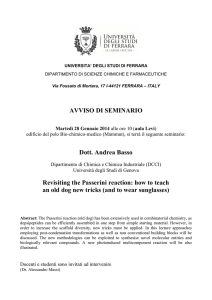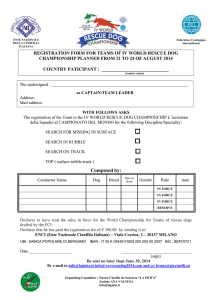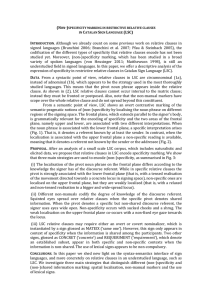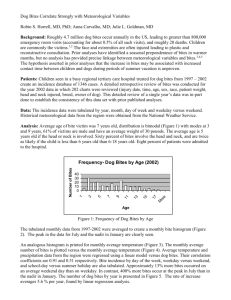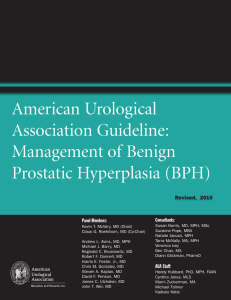Highly-Trained Dogs` Olfactory System Detects Prostate Cancer in
advertisement
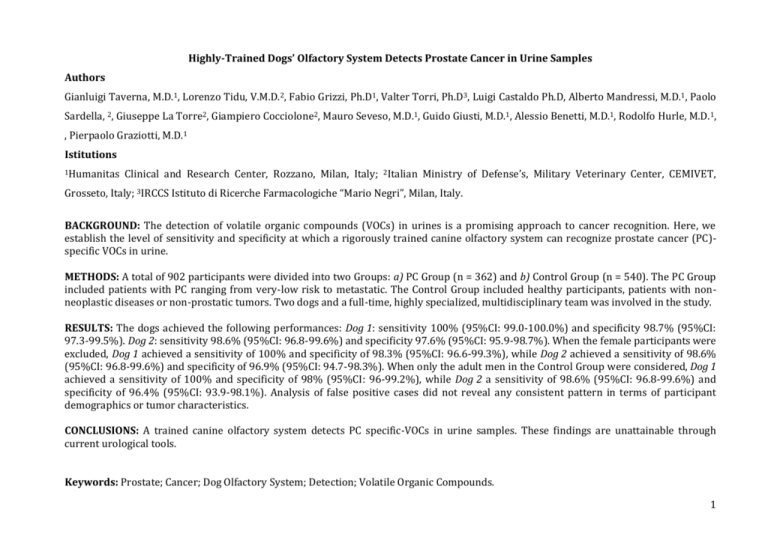
Highly-Trained Dogs’ Olfactory System Detects Prostate Cancer in Urine Samples Authors Gianluigi Taverna, M.D.1, Lorenzo Tidu, V.M.D.2, Fabio Grizzi, Ph.D1, Valter Torri, Ph.D3, Luigi Castaldo Ph.D, Alberto Mandressi, M.D.1, Paolo Sardella, 2, Giuseppe La Torre2, Giampiero Cocciolone2, Mauro Seveso, M.D.1, Guido Giusti, M.D.1, Alessio Benetti, M.D.1, Rodolfo Hurle, M.D.1, , Pierpaolo Graziotti, M.D.1 Istitutions 1Humanitas Clinical and Research Center, Rozzano, Milan, Italy; 2Italian Ministry of Defense’s, Military Veterinary Center, CEMIVET, Grosseto, Italy; 3IRCCS Istituto di Ricerche Farmacologiche “Mario Negri”, Milan, Italy. BACKGROUND: The detection of volatile organic compounds (VOCs) in urines is a promising approach to cancer recognition. Here, we establish the level of sensitivity and specificity at which a rigorously trained canine olfactory system can recognize prostate cancer (PC)specific VOCs in urine. METHODS: A total of 902 participants were divided into two Groups: a) PC Group (n = 362) and b) Control Group (n = 540). The PC Group included patients with PC ranging from very-low risk to metastatic. The Control Group included healthy participants, patients with nonneoplastic diseases or non-prostatic tumors. Two dogs and a full-time, highly specialized, multidisciplinary team was involved in the study. RESULTS: The dogs achieved the following performances: Dog 1: sensitivity 100% (95%CI: 99.0-100.0%) and specificity 98.7% (95%CI: 97.3-99.5%). Dog 2: sensitivity 98.6% (95%CI: 96.8-99.6%) and specificity 97.6% (95%CI: 95.9-98.7%). When the female participants were excluded, Dog 1 achieved a sensitivity of 100% and specificity of 98.3% (95%CI: 96.6-99.3%), while Dog 2 achieved a sensitivity of 98.6% (95%CI: 96.8-99.6%) and specificity of 96.9% (95%CI: 94.7-98.3%). When only the adult men in the Control Group were considered, Dog 1 achieved a sensitivity of 100% and specificity of 98% (95%CI: 96-99.2%), while Dog 2 a sensitivity of 98.6% (95%CI: 96.8-99.6%) and specificity of 96.4% (95%CI: 93.9-98.1%). Analysis of false positive cases did not reveal any consistent pattern in terms of participant demographics or tumor characteristics. CONCLUSIONS: A trained canine olfactory system detects PC specific-VOCs in urine samples. These findings are unattainable through current urological tools. Keywords: Prostate; Cancer; Dog Olfactory System; Detection; Volatile Organic Compounds. 1
